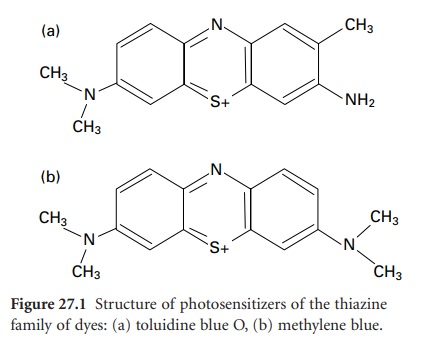Photodynamic Therapy (Photoactivated Disinfection)
| Home | | Pharmaceutical Microbiology | | Pharmaceutical Microbiology |Chapter: Pharmaceutical Microbiology : Alternative Strategies For Antimicrobial Therapy
The therapeutic effects of light have been known for thousands of years and the combination of light with various chemicals again dates back to ancient times. It was only at the beginning of the 20th century, however, that the scientific basis of this phenomenon began to be explored.
PHOTODYNAMIC THERAPY (PHOTOACTIVATED DISINFECTION)
The therapeutic effects of light have
been known for thousands of years and the combination of light with various
chemicals again dates back to ancient times. It was only at the beginning of
the 20th century, however, that the scientific basis of this phenomenon began
to be explored. The use of photosensitizing agents to kill microorganisms was
first shown in 1900 and it was shortly after this that the term photodynamic therapy (PDT) was coined. This
chapter only discusses the use of this technique for the killing of
microorganisms, although it should be pointed out that PDT has also been used
to treat tumours using a combination of photosensitizing porphyrin compounds
and laser light.
The most common photosensitizers used
for their antimicrobial effects are the thiazine dyes methylene blue and
toluidine blue O (also known as tolonium chloride; Figure 27.1).
Both of these molecules carry a positive charge and this enables them to
interact with the negatively charged outer surfaces of bacteria. In particular,
they accumulate at the cytoplasmic membrane and when activated cause lethal
damage to that target site. It has been found that Gram-positive bacteria are more
sensitive to PDT than Gram-negative bacteria, because of the different nature
of their cell walls .

The light sources used in the recent past have been lasers which produce
light of a defined waveband designed to match the peak excitation wavelength of the photosensitizer used. Lasers also have the advantage of being able to be passed through thin, flexible fibres for
use in difficult-to-access areas. More recently, advances in the development of light-emitting diodes (LEDs),
particularly in respect
of their increasing power, has enabled
these to be used under some circumstances in place of lasers with obvious benefits of safety and
cost. Toluidine blue O has an absorbance peak of ±11 nm around
the maximum and so is suitable for use in conjunction with these systems.
A detailed
discussion of the
mechanism of antimicrobial action of light-activated photosensitizers is outside
the scope
of this chapter
and the reader
is referred to Wainwright (1998) for further
information. However,
in brief, the photosensitizer which is adsorbed on to the bacterial cell will, when
illuminated, give rise
to the production of toxic
singlet oxygen which
is very short-lived but highly destructive. This singlet oxygen is present
only when the photosensitizer is excited by light and does not persist once the light
is extinguished. The toxic effect
is confined to bacteria and
the photosensitizer does not appear to have any adverse
effects on normal
tissue.
PDT is essentially a highly efficient disinfection process
which is harmless to surrounding tissues. The limitations of the system
are associated with
the ability of both the dye and the light to penetrate the
matrix in which
the bacteria are located. The main use for the technology is therefore to treat localized, surface infections which
are not particularly amenable
to systemic therapy. It has been used extensively for
infections in dentistry, particularly root canal
infections, periodontitis and caries, and devices
are commercially available
for use in dental surgeries. Applications have also been found
in dermatology, ophthalmology and ENT infections. It seems likely
that the range of conditions appropriate for this technology will grow in the future, although
the nature of the process
is such that
it will be a niche
market treating localized, difficult-to-manage infections.
